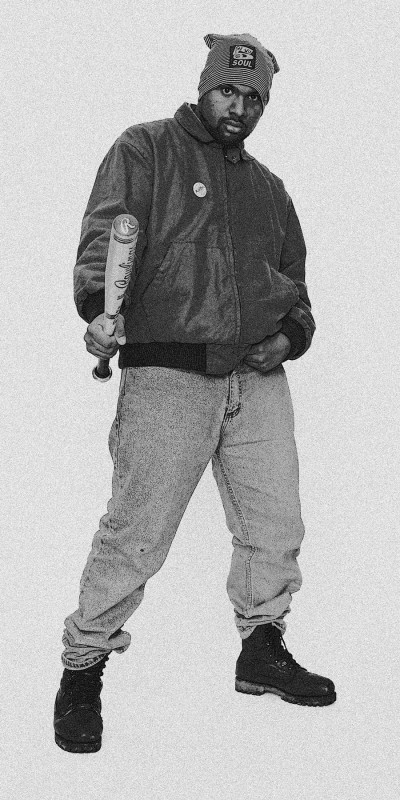
Acrylic on Aluminum
78 x 39 in
Edition of 3
Born in London in 1969, Faisal Abdu’Allah is a British artist whose work primarily evolves from the interface of photography, the printed image and lens-based installation. He constantly repositions values and ideologies pertaining to representation. Abdu’Allah is a senior lecturer in Fine Art at the University of East London. He lives and maintains a studio in London.
– Artist’s website
* * *
“So if you see a man in red, white and blue/ getting chased by the Lench Mob Crew/ it’s a man who deserves to buckle/ I wanna kill Sam cause he ain’t my motherfucking uncle.”
Ice Cube, “I Wanna Kill Sam”
I Wanna Kill Sam is a work that is provocatively direct in its immediacy. The work is inspired from Ice Cube’s second solo album in 1991, Death Certificate. One of the album tracks, “I Wanna Kill Sam” proclaims, “The army is the only way out for young, black teenagers…[because]/ …We’ll provide you with everything you need in life.” However like the disingenuous promise of “forty acres and a mule” after emancipation, this vow proves untrue also. Ice Cube charges several offences to “Uncle Sam” from breaking up black families under slavery to spreading HIV and drug use amongst them and consequently, Ice Cube ends the song by avenging to kill Sam because of this exploitation under false pretenses.
In his work of the same name, Abdu’Allah critically engages with Ice Cube’s account of US army recruitment of African Americans to explicate British history. Lord Kitchener appears in the place of Uncle Sam. As War Secretary in 1914, he is featured on posters in a massive recruitment campaign, proclaiming, “Britons, [Lord Kitchener] wants you – join your country’s army!” One of the most enduring images of the war and beyond it, it inspired a similar iteration in the United States, in which Uncle Sam is featured in place of Lord Kitchener. In Abdu’Allah’s I Wanna Kill Sam, Lord Kitchener, like Uncle Sam in Ice Cube’s song, is identified as a harbinger of death. In its very first incarnation at the Royal College of Art in London, this work was installed in a small, white room and at its centre lays a glass coffin. Printed upon the glass is a draped flag bearing the haughty face of Lord Kitchener, the famous British Field Marshall and Secretary of State for War during the first World War, immortalized in posters of the period campaigning the war effort. Since its first showing, the work has not been exhibited with the coffin as it necessitates an enclosed space to show the work.
Like Ice Cube, the men on the [aluminum] are lyricists also. Members of the British rap group, Scientists of Sound, they are personal acquaintances of Abdu’Allah, and crucially, were instrumental in his reversion to Islam. The work can be seen as representative of Abdu’Allah’s metaphoric death as Paul Duffus, his given name at birth and rebirth as Faisal Abdu’Allah, his chosen name upon his reversion.
Criticized for perpetuating the “violent black male” stereotype, the work effectively challenges these stereotypes by its reclamation of such assumptions by the subjects themselves. Each of the men photographed had an active involvement in realizing their own image. They wore their own clothing, wielded their own props and chose the final image that would represent them. One of the first major works in which Abdu’Allah uses the production of original photographs (as opposed to found images), there is a direct sense of ownership and mediation of these bodies by both the artist and his subjects. Moreover the work does more than refute stereotype – it erodes them. Here, there is not simply the depiction of an image but the disintegration of images also. Figures appear to dissolve into cold [metal], flashing in and out of vision and thus, in and out of existence.
– Rachel Newman in “The Art of Dislocation,” pp. 33-34; OrbisAfrica Graphic Writing Systems lab and the Stanford Department of Art and Art History, CA, 2010
show prices
Prices and availability are subject to change without notice.The copyright of all art images belongs to the individual artists and Magnolia Editions, Inc.
©2003-2025 Magnolia Editions, Inc. All rights reserved. contact us
